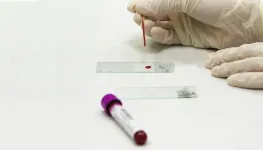(Press-News.org) Misconceptions about dyslexia are held by professionals who assess children for the learning difficulty, according to a new study which calls for evidence-based standardised assessment procedures.
The research, led by Durham University, found that almost half of dyslexia professionals in the study believed at least one unproven indicator for dyslexia, which could lead to children being misdiagnosed.
In a survey of 275 dyslexia professionals, the most common myth – which is not backed up by solid evidence – was that people with dyslexia read letters in reverse order, believed by 61 per cent of specialists.
Just over 30 per cent of professionals also believed that letters jumping around is a key feature of dyslexia. However, there is currently no evidence to show that either of these are reliable indicators of dyslexia.
The survey targeted a range of UK professionals involved in assessing students for dyslexia, such as dyslexia specialists, specialist assessors and educational psychologists. They were asked about the assessments they used, how they make their decisions on diagnosis and what they believe to be indicators of dyslexia.
Although over 75 per cent of professionals used assessments which are recommended by the Specific Learning Difficulty (SpLD) Assessment Standards Committee (SASC), more than 82 per cent of respondents also used additional measures. A further 71 different measures were listed by participants, indicating that there are many different tests used by professionals during the assessment process.
In the UK, there is currently no official policy guidance on defining and identifying students with dyslexia or other learning difficulties. Instead, the onus of developing diagnostic procedures and standards relies heavily on various independent professional organisations.
The researchers are calling for evidence-based knowledge to be built into the assessment procedures and for this to be guided by government policy.
The study, funded by the British Educational Research Association (BERA), is published in Annals of Dyslexia and involved researchers from Durham University and National Taiwan Normal University.
Lead author, Dr Johny Daniel from the School of Education at Durham University, said:
“Our findings show that there is a need for government policy to guide how students with reading disabilities should be assessed, based on reliable evidence.
“It’s also important that dyslexia and psychological associations in the UK ensure that any misconceptions amongst professionals are directly addressed in their guidelines so that children are assessed in a consistent way across the board.”
It's estimated up to one in every 10 people in the UK has some degree of dyslexia.
The research uncovered a general lack of consensus amongst assessors on the process of identifying someone with dyslexia. Many did subscribe to the notion of dyslexia being a deficit in core areas of reading, but several others saw it as a discrepancy between individuals’ reading and cognitive abilities.
The dyslexia specialists in the study also used a number of other unsubstantiated dyslexia indicators such as high levels of creativity (17 per cent), motor skills issues or clumsiness (17 per cent), and difficulty with reading words in certain colours (15 per cent) or fonts (12 per cent). Empirical data do not support these to be indicators of dyslexia.
Dr Daniel added: “Early identification is absolutely crucial so that support can be put in place as quickly as possible. However, our study shows there is significant variability in the methods used for identifying reading disabilities such as dyslexia, which could lead to children being misdiagnosed or missed altogether.”
END
Misconceptions about dyslexia among professionals risk children being misdiagnosed
2024-08-29
ELSE PRESS RELEASES FROM THIS DATE:
Breakthrough in semiconductor patterning: New block copolymer achieves 7.6 nm line width
2024-08-29
A recently developed block copolymer could help push the limits of integration and miniaturization in semiconductor manufacturing, report scientists in Tokyo Tech and TOK. Chemically tailored for reliable directed self-assembly, the proposed compound can arrange itself into perpendicular lamellar structures whose half-pitch width is less than 10 nanometers, outperforming conventional and widely used block copolymers.
Miniaturization is one of the fundamental qualities of modern electronics and is largely responsible for the incredible increments in performance witnessed ...
Fission chips – How vinegar could revolutionize sensor processing
2024-08-29
Researchers at Macquarie University have developed a new way to produce ultraviolet (UV) light sensors, which could lead to more efficient and flexible wearable devices.
The study, published in the journal Small in July, shows how acetic acid vapour – essentially vinegar fumes – can rapidly improve the performance of zinc oxide nanoparticle-based sensors without using high-temperatures for processing.
Co-author Professor Shujuan Huang, from the School of Engineering at Macquarie University, says: “We found by briefly exposing the sensor to vinegar vapour, adjoining ...
Certain diabetes drugs might prevent dementia
2024-08-29
Sodium-glucose cotransporter-2 (SGLT-2) inhibitors used to treat type 2 diabetes might prevent dementia, providing greater benefits with longer treatment, suggests a large study from Korea published by The BMJ today.
As this study was observational, the researchers note that the effect size could have been overestimated and say randomised controlled trials are now needed to confirm these findings.
According to the World Health Organization, the number of people with dementia globally is expected to reach 78 million ...
Lower HPV vaccination coverage among girls with mental health conditions
2024-08-29
Girls with mental illness or neurodevelopmental conditions are less likely than their peers to be vaccinated with the HPV vaccine that protects against future cervical cancer. This is according to a new registry study from Karolinska Institutet in Sweden published in The Lancet Public Health.
The study involved more than 115,000 girls covered by the Swedish school-based human papillomavirus (HPV) vaccination programme. The vaccine, which prevents cervical cancer, among other things, is offered to all children in Sweden and given by school health services.
Significant ...
Scientists discover how the body's killer cells attack cancer
2024-08-29
Scientists are on the verge of a cancer breakthrough after working out how the body’s immune system targets cells devastated by the disease.
A new study has discovered that our natural killer cells, from the immune system which protect against disease and infections, instinctively recognise and attack a protein that drives cancer growth.
The experts say that by hijacking this protein, known as XPO1, they may be able to activate more killer cells to destroy the disease.
Scientists from the University of Southampton, working with experts worldwide, led the study and now believe it could offer new ...
Interprofessional training in health sciences education has a lasting impact on practice
2024-08-29
Geriatrics experts have long known that collaboration is key to delivering quality, patient-centered care to older adults.
That’s why USC’s Interprofessional Education and Collaboration for Geriatrics (IECG) trains up to 150 students annually from seven health professions to teach the importance of teamwork in meeting the complex needs of the elderly.
Now, a study published in the Journal of Interprofessional Care highlights the long-term impact of IECG on USC health sciences graduates.
Researchers surveyed graduates one to three years after completing IECG to assess how the program influenced their practice. The findings were significant: 81% ...
Study reveals molecular mechanism behind MS and other autoimmune diseases
2024-08-28
New Haven, Conn. — More than two decades ago, a research team in the lab of David Hafler, a Yale researcher who at the time was at Harvard, discovered a type of T cell in humans that suppresses the immune system; they later found that these so-called regulatory T cells, when defective, are an underlying cause of autoimmune disease, specifically multiple sclerosis (MS). For many years, however, the mechanism behind this dysfunction has remained unclear.
In a new Yale-led study, a team of researchers finds that this loss of immune regulation is triggered by an increase in PRDM1-S, a protein involved in immune function, ...
To build a thriving electric vehicle market, prioritize equity and justice
2024-08-28
When it comes to purchasing and using electric vehicles (EVs), housing- and income-related factors significantly shape perceptions and preferences among potential buyers, finds a new study in Energy and Climate Change. This research, a collaboration between the Boston University Institute for Global Sustainability (IGS) and the U.S. Department of Energy’s National Renewable Energy Laboratory (NREL), is among the first to examine both EV adoption and charging infrastructure through an equity lens coupled with state-of-the-art original survey data.
Understanding the barriers to widespread EV adoption ...
Large language models can help detect social media bots — but can also make the problem worse
2024-08-28
An external study of Twitter in 2022 estimated that between a third and two thirds of accounts on the social media site were bots. And many of these automatons flooding social media are dispatched to sow political polarization, hate, misinformation, propaganda and scams. The ability to sift them out of the online crowds is vital for a safer, more humane (or at least more human) internet.
But the recent proliferation of large language models (known as "LLMs" for short), such as OpenAI’s ChatGPT and Meta’s Llama, ...
How beetle juice led to the discovery of a virus and solved the mystery of a superworm die-off
2024-08-28
Rutgers University-New Brunswick scientists have discovered a virus that caused a nationwide die-off of superworms, a common food for birds, reptiles, other pets and, more and more so, even for humans as an alternative protein source. In doing so, they pioneered a different way to search for and identify emerging viruses and pathogens in humans, plants and animals.
Using chopped up beetle carcasses forming a slurry and an electron microscope cooled by liquid nitrogen, the scientists reported today in Cell that they have discovered what they have titled Zophobas morio black wasting virus. The name is derived from ...


